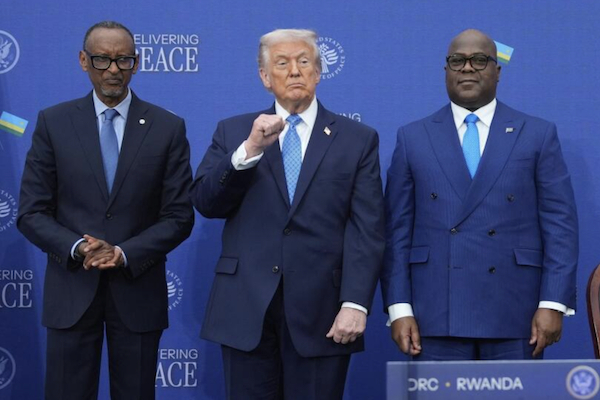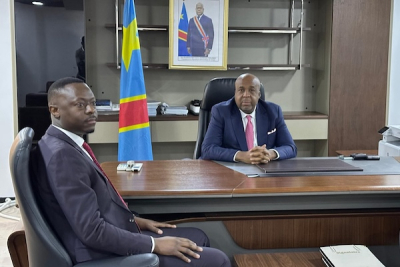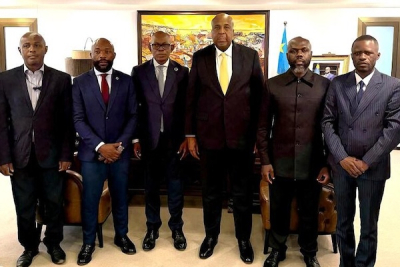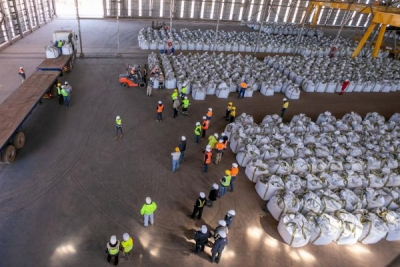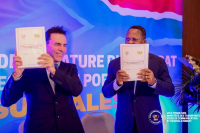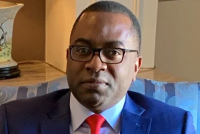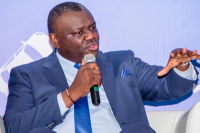
News (571)
A tripartite cooperation framework on strategic minerals involving the Democratic Republic of Congo (DRC), the United States and Rwanda was launched in Washington on Dec. 4, 2025.
The Regional Economic Integration Framework (REIF), which serves as the economic pillar of a peace accord, was signed by Kinshasa and Kigali after a preliminary signing on Nov. 7. Alongside the accord, the United States concluded two separate bilateral agreements with the DRC and Rwanda. All documents were signed during a ceremony at the U.S. Institute of Peace attended by Presidents Felix Tshisekedi of the DRC, Paul Kagame of Rwanda and Donald Trump of the United States.
At a press briefing in Washington, Daniel Mukoko Samba, the DRC’s Vice Prime Minister for the National Economy, outlined the purpose of the three-way framework. “As relations between the DRC and Rwanda move toward a more peaceful path centered on shared prosperity, it is also important for the sponsor of this process to secure access to critical metals,” he said. The official added that in today’s geopolitical landscape, access to strategic minerals is essential for any state seeking to become or remain a global power.
Andre Wameso, now Governor of the Central Bank of the Congo and a former economic adviser who took part in negotiations with Rwanda and the United States, said the REIF guarantees that access to strategic resources in eastern DRC will now be negotiated exclusively with national authorities. Wameso argued that the conflict in the country’s east, ongoing for three decades, did not originate from a bilateral dispute between Kinshasa and Kigali but from a Western strategy aimed at bypassing Congolese authorities who opposed the privatization of the mining sector at the time.
A Minerals-for-Security Agreement
The REIF seeks to usher in what Donald Trump described as “a new era of harmony and cooperation” between the DRC and Rwanda by addressing a key driver of the conflict: opaque mineral supply chains. U.S. officials say the framework “unlocks the vast economic potential of the Great Lakes region and creates opportunities for the U.S. private sector.” Commenting on the DRC’s resources, Trump said, “There is tremendous wealth in this land,” adding that U.S. companies would invest in rare earth extraction. “Everybody is going to make a lot of money,” he declared.
A long-discussed “minerals-for-security” pact between Washington and Kinshasa has also been finalized. Congolese officials said two documents were signed: a strategic partnership agreement covering economic and commercial matters, and a memorandum of understanding on security and defense cooperation.
“The relationship between the U.S. and Congolese governments has entered a new phase,” Mukoko Samba said. “Until now, economic ties were governed by an investment protection agreement dating back to 1984. Today, we are strategic partners on economic and trade issues, on defense and security, on science and technology, and on governance.”
Background and Early Moves
Separately, the United States and Rwanda signed the “Shared Economic Prosperity Framework Agreement,” which also addresses strategic minerals, according to press reports. In October 2025, the U.S. received its first shipment of tungsten concentrate from Rwanda, sourced from the Nyakabingo mine and processed in Pennsylvania under a partnership involving Trinity Metals, Global Tungsten & Powders and Traxys.
With Washington and Kinshasa expected to deepen economic ties, several U.S. firms are already active in the DRC, including Kobold Metals in mining and Starlink in satellite internet. The U.S. is also contributing to development of the Lobito Corridor, which links southeastern DRC’s mining regions to the Atlantic coast.
Congolese authorities caution, however, that the triangular cooperation framework can only be fully implemented once peace returns to the country’s east. Despite the signing of the June 27 peace agreement in Washington, violence has recently flared again in South Kivu, leading to new population displacements.
Pierre Mukoko
The U.S. company Minerals Mining Company (Miminco) has had its two operating permits in Kasai province revoked for failing to pay required surface fees. The information appears in a list of forfeiture orders issued by the Ministry and published by the Mining Cadastre (CAMI) on December 2, 2025. Three other companies also lost their mining titles for the same reason. The measure is part of the Congolese government’s effort to strengthen compliance in the mining sector.
Miminco is known for initiating the seizure of a Congo Airways Airbus A320 in Dublin in 2015 as part of a dispute with the Democratic Republic of Congo (DRC). The company accused the state of failing to honor a compensation agreement reached after arbitration.
The dispute stemmed from the occupation of Miminco’s diamond concessions in Kasai, first by members of the Presidential Special Division during the Zaire era, and later by the Alliance of Democratic Forces for the Liberation of Congo (AFDL) under Laurent-Désiré Kabila. After proceedings before the International Centre for Settlement of Investment Disputes (ICSID), the Congolese state agreed in a 2007 settlement to pay the company nearly 13 million dollars. Miminco was founded by Dr. Ilunga Jean Mukend, a Congolese-American physician.
According to CAMI’s register seen by Bankable, the revoked permits were granted on November 21, 2015, after the plane seizure incident. The concessions are located in the Kamonia mining zone in Kasai province. The two cancelled operating permits cover a total of 61 mining blocks.
Under the Mining Code, companies subject to forfeiture orders have 30 days from notification and publication to appeal the decision to the relevant authorities. If no appeal is filed, the forfeiture is entered in the CAMI register and published in the Official Journal, at which point it becomes final.
On September 12, Kasai province signed a memorandum of understanding with CAMI to improve oversight and collection of surface fees on mining concessions and boost provincial revenue. CAMI General Manager Popol Mabolia Yenga said the agreement includes technical and institutional support, data sharing between cadastral systems and training for provincial staff.
Timothée Manoke
DRC plans to adjust water and electricity tariffs that have long been set by ministerial decree and kept below actual production costs. The national utilities, SNEL and REGIDESO, have argued for years that such pricing prevents them from maintaining reliable service and investing in infrastructure upgrades.
Speaking at the Makutano Forum on November 26, 2025, Minister of Hydraulic Resources and Electricity Aimé Molendo Sakombi said he had submitted a memo to the Council of Ministers proposing a six-month emergency plan for REGIDESO. The plan calls for liberalizing tariffs to bring them in line with actual costs and for settling the government’s arrears to the utility.
Asked about electricity, the Minister said the situation was similar. He added that additional memos were being prepared and that the government intended to “take the bull by the horns.” Under the National Energy Compact, the government’s roadmap to raise electricity access from 21.5 percent to 62.5 percent by 2030, the state committed to adopting a tariff regime by January 2026 that would allow SNEL to cover the cost of providing reliable service.
Speaking on Top Congo FM on December 1, 2025, REGIDESO General Manager David Tshilumba said the planned adjustment to the social water tariff would gradually raise it above 0.43 dollars per cubic meter, representing an increase of roughly 80 to 100 percent. He emphasized that the change would be phased in over several years and applied in stages.
Tshilumba added that the Deputy Prime Minister and Minister of National Economy had told him it was time to resolve the issue and that the matter would be addressed through the Council of Ministers.
Below-Cost Pricing
According to Tshilumba, the current tariff for households averages about 0.25 dollars per cubic meter, while the production cost is around 1.15 dollars. He said a cost-reflective tariff is necessary for the company to operate sustainably without heavy state subsidies. Households account for 80 percent of REGIDESO’s water consumption, while commercial and industrial users, who pay more than 2 dollars per cubic meter, represent only 20 percent of demand.
The utility also faces significant unpaid government bills. Tshilumba estimates state arrears at 628 billion Congolese francs. With the settlement of these arrears and the gradual adjustment of tariffs, REGIDESO plans to diversify its activities to expand its revenue base. Water sales currently account for 95 percent of its revenue, according to Bloomfield Investment.
In that context, REGIDESO announced in 2024 the construction of a factory in the Maluku Special Economic Zone to produce pipes and plumbing equipment. Ten hectares have already been allocated to the project, according to Radio Okapi, citing SEZ Agency General Manager Auguy Bolanda. The utility has also created a subsidiary for electricity production, RégiEnergies, and is preparing to launch bottled water sales in Kinshasa.
On the electricity side, SNEL sells power at an average rate of 0.17 dollars per kilowatt-hour under a decree issued on November 5, 2022. When fixed tariffs are included, the National Energy Compact estimates the effective rate at about 0.09 dollars, which remains insufficient to cover production costs.
Mini-grid operators apply authority-approved tariffs that are higher than SNEL’s, ranging from 0.25 to 0.70 dollars per kilowatt-hour, according to the National Energy Compact. Virunga Energies, active in North Kivu, reports selling electricity at 0.25 dollars per kilowatt-hour for households and 0.235 dollars for small and medium-sized businesses.
Pierre Mukoko & Timothée Manoke
The Democratic Republic of Congo is moving forward with plans to host the headquarters of the Central Africa Electricity Regulatory Commission (CORREAC) , the body responsible for regulating the electricity market within the Economic Community of Central African States (ECCAS).
The progress follows an ECCAS mission that visited Kinshasa from Nov. 24 to 28, 2025. The delegation was led by Energy Director Désiré Armand Ndemazagoa Backotta, representing the president of the Commission.
According to the Congolese Electricity Regulatory Authority (ARE), which released the mission’s findings, the official inauguration of the CORREAC headquarters is scheduled for the first quarter of 2026. A first assessment mission was carried out in Kinshasa from Oct. 7 to 10, 2025.
Following that initial visit, the ARE concluded that the DRC met the required conditions to host the institution. These included community contributions, availability of suitable facilities and a commitment to finalize a headquarters agreement before the end of 2025.
CORREAC will serve as the regional regulator for electricity trade and markets among ECCAS member states. Its responsibilities will include overseeing cross-border power flows, regulating tariffs, harmonizing operating rules, managing disputes and supervising the regional market.
According to the National Energy Compact, which aims to raise the country’s electricity access rate from 21.5% to 62.5% by 2030, the DRC intends to position itself as Central Africa’s energy hub. The roadmap sets out an ambitious regional integration agenda, including tariff harmonization, technical interconnections, transnational energy corridors, intergovernmental agreements, participation in regional power pools and infrastructure adapted for electricity exports.
The idea of creating a regional regulator originated within the Central African Power Pool (PEAC), the ECCAS institution responsible for coordinating energy policies, promoting interconnections and facilitating regional electricity trade. The goal is to build an integrated market capable of harnessing the region’s energy potential, particularly hydropower, while providing regulatory oversight, pricing coordination and joint management of cross-border flows.
The groundwork began in July 2022, when delegates from member states met in Kinshasa under the leadership of the DRC’s ARE to draft the statutes, define the institutional organization, establish headquarters requirements and outline the operational framework for the future regulator.
Since then, the initiative has advanced steadily. In 2024, the Project to Support the Development of the Institutional and Regulatory Framework for Electricity in Central Africa (Padcre-AC) was launched with African Development Bank support to help make CORREAC operational, fund the startup unit, recruit key staff and prepare the regional regulatory framework.
The next steps include signing the headquarters agreement before the end of 2025, installing the startup unit head and legal expert in Kinshasa in January 2026, and officially inaugurating the CORREAC headquarters in the first quarter of 2026.
Boaz Kabeya
The Kamoa-Kakula copper mine in the Democratic Republic of Congo is not expected to reach 500,000 tons of annual production until 2027, operator Ivanhoe Mines said on Wednesday, as repair work continues following a seismic event in May.
Since beginning production in 2021, output at Kamoa-Kakula has increased steadily, rising from 333,500 tons in its first full year in 2022 to a record 437,061 tons in 2024.
Ivanhoe had planned to accelerate that growth in 2025 with the launch of a third processing plant, which was expected to boost production to between 520,000 and 580,000 tons.
Those targets were revised downward after the seismic incident, which primarily affected the underground Kakula section of the mine. Production is now forecast to peak at around 420,000 tons in 2025, with a similar ceiling expected in 2026, before increasing to roughly 540,000 tons in 2027.
The outlook assumes a gradual improvement in mining and processing rates as repair work at Kakula progresses. Ivanhoe said a full update to Kamoa-Kakula’s long-term operating plan is under preparation.
Kamoa-Kakula is the DRC’s largest copper mine and one of the biggest in the world. The Congolese state holds a 20 percent stake, while Ivanhoe Mines and Chinese partner Zijin Mining each own 39.6 percent and Crystal River Global Limited holds 0.8%
Aurel Sèdjro Houenou, Ecofin Agency
DRC authorities and the French Development Agency (AFD) have launched a 50 million euro (nearly 60 million dollar) project in Boma. The initiative is designed to modernize urban infrastructure and strengthen the city’s resilience to climate change in Kongo Central province.
The launch follows the signing of two loan agreements between the Democratic Republic of Congo (DRC) and France, through AFD, on March 14, 2025. The agreements support a digital transformation and multi-sector sustainable development program for the city of Boma. The financing package, which includes a 40 million euro loan and a 10 million euro grant, is part of the cooperation framework between the DRC and France.
According to Hervé Conan, AFD Director in the DRC, the project is intended to “revitalize the city, make it more attractive and test an integrated pilot approach to building sustainable and resilient cities that can be replicated across the DRC.” Conan also said Boma was chosen because of its former status as the capital, its strategic location and the project’s alignment with other AFD-funded projects in the region.
The project includes urban development works, the preparation of a territorial development plan, improvements to road networks and urban services, and capacity building for local stakeholders. The 10 million euro grant will fund technical assistance provided by Expertise France and the rehabilitation or construction of targeted infrastructure, including the “Maison des jeunes” (Youth Center), a sports complex and the future “Maison des femmes” (Women’s Center), a space dedicated to supporting and empowering women.
These activities are expected to help restore essential infrastructure, improve access to urban services, support local economic activity, with a goal of increasing the income of at least 5,000 women, and strengthen local governance.
At the national level, the Ministry of Territorial Planning oversees the project. It is implemented by the Project Management Unit (UGP), an administratively and financially autonomous body that reports to the Ministry of Finance. Locally, the National Agency for Territorial Planning (ANAT) and Boma city hall are responsible for coordination.
Boaz Kabeya
The Office of Multimodal Freight Management (OGEFREM) signed a concession agreement on Dec. 1, 2025, with the Yellowstone Consortium for the construction and operation of the Kasumbalesa dry port. The signing, which completes a year-long process to select a financing partner, took place in the presence of Transport Minister Jean-Pierre Bemba.
Strategic Location and Project Scope
The agreement concludes efforts to secure a partner capable of financing and delivering the project. Kasumbalesa sits at the crossroads of several regional corridors that connect seven African seaports: Dar es Salaam, Beira, Nacala, Durban, Walvis Bay, Lobito and Luanda. The town, located along National Road No. 1, also links Zambia’s Copperbelt to the former Katanga province, two of the region’s most productive mining areas.
Although the contract terms were not disclosed, the pre-qualification notice outlines the private partner’s obligations. The partner must finance, build and equip 13,500 square meters of warehouses, expandable to 34,000 square meters, two container yards, a hydrocarbon storage area, and truck parking areas with an estimated capacity of about 1,800 spaces.
The project also includes parking for cars and motorcycles, two administrative buildings, internal roads, an electricity delivery station, and a water pumping station with a storage tower. A fire station and rest facilities are also planned.
Investment and Concession Terms
The private partner will develop a land reserve at the site’s entrance that will host a service station, retail outlets, and repair and washing facilities for vehicles.
In return for its investment, the state is expected to grant the operator a concession for the infrastructure’s operation and maintenance. The duration will be set according to the project cost, maintenance requirements and expected revenue. During the Council of Ministers meeting of Feb. 4, 2022, the project cost was estimated at nearly 129 million dollars.
Yellowstone is a South African consortium that specializes in the design, financing, construction and operation of logistics infrastructure including dry ports, transit hubs, truck parks and industrial zones. The company highlights its multidisciplinary expertise in engineering, management, finance and operations, which it says enables it to deliver integrated and turnkey projects. It operates in several Southern African markets and promotes modern construction standards that support the smooth flow of regional transport.
Boaz Kabeya
REGIDESO will build a 15 MW solar plant to ease Mbuji-Mayi’s water shortages, its director general said at the Makutano forum on November 26, adding that work begins in January 2026.
He was responding to a resident who said she receives water only once a week. He explained that the project aims to fix power supply shortfalls that regularly disrupt the city’s water distribution.
REGIDESO currently depends on electricity from the national utility SNEL, which itself relies on power from the Tubi-Tubidi hydroelectric plant owned by the mining company SACIM. Frequent failures at the plant cause repeated outages that prevent uninterrupted drinking water supply. This persists even though Mbuji-Mayi’s 500 km pipeline network, considered one of the most modern in the country, is in good condition.
The utility says it has generators, but current tariffs do not cover their sustained operation. “The tariff is lower than production costs. We have raised this with the government for more than three years. We cannot produce water at $1.15 per cubic meter and sell it to households for 0.25 cents,” Tshilumba said.
He added that technical assessments for the photovoltaic plant are complete and that the project will be financed by German cooperation. Radio Okapi earlier reported that Germany had announced an initial 8 MW solar project for REGIDESO in 2022 to reduce its dependence on SNEL. The increase to 15 MW may reflect updated demand estimates, with Tshilumba saying the city now needs between 12 and 13 MW for normal service.
REGIDESO also plans to replicate this self-generation model in other provinces through its subsidiary RégiEnergies, created between 2023 and 2024. Its mission is to supply electricity in areas where SNEL’s service is insufficient or absent, particularly in remote regions. The move revives part of REGIDESO’s historical mandate. When the utility was created in 1939, it handled both water and electricity distribution until the government transferred the electricity portfolio to SNEL in 1978.
Timothée Manoke
DRC Transport Minister Jean-Pierre Bemba said Wednesday that Equity BCDC will finance the purchase of 1,000 buses for the public transport operator Transco, a move meant to improve transport in Kinshasa and other cities.
Speaking at the Makutano forum, Bemba said negotiations on the deal are almost complete. He said the financing is supported by a digital ticketing system for Transco that Equity BCDC has already funded.
The minister explained that the system allows the bank to track revenues in real time, ensuring loan repayment because each ticket sale is automatically deposited into a dedicated account.
In October, Transco Director General Sylvestre Bilambo and Equity BCDC CEO Willy Mulumba Kabadi met with Bemba to review progress on the initiative. During the meeting, Mulumba reaffirmed the bank’s commitment to improving transport services in Kinshasa.
Bemba said the partnership demonstrates that reliable risk-mitigation tools exist in the sector and urged other banks to finance similar projects.
Ronsard Luabeya
The Democratic Republic of Congo plans to tighten oversight of major digital platforms operating in the country, Digital Economy Minister Augustin Kibassa said on Tuesday.
Speaking at the Africa Digital Innovation Summit (ADIS 2025) in Kinshasa, Kibassa cited Facebook, Twitter and TikTok among the companies that, he said, operate in the DRC with little supervision while earning substantial revenue from the local market.
Kibassa said talks are advancing, with several options under review, including a regional approach involving neighboring states. He said he also wants to work through African coalitions to strengthen countries’ bargaining power with global digital firms. The minister said he has already begun discussions with the Smart Africa alliance, though progress remains limited for now.
“They operate here and profit heavily from our market. That weakens our economy. I believe it is in their interest to listen to us,” he said.
Kibassa also called for tighter rules on the content carried by these platforms. He pointed to TikTok, saying its content is more tightly controlled and education-oriented in China, unlike what is accessible in the DRC. He said a stronger framework, backed by penalties, is needed to curb abuses seen on social networks. He added he plans to work with the communication ministry to reinforce the national system for regulating digital content and services.
The steps taken by Kinshasa mirror a broader global push to rein in digital giants. In Europe, the European Union and several member states have stepped up efforts in recent years to regulate large online platforms. The EU’s Digital Services Act, in force since August 2023 and applicable to all digital services from February 2024, aims to improve consumer protection and tighten oversight of platform practices.
Ronsard Luabeya
More...
Democratic Republic of Congo's Kakobola hydroelectric plant will be commissioned within the next 47 days, by January 2026, the minister of water resources and electricity said on Wednesday.
Aimé Sakombi Molendo announced the timeline for the 10.5-megawatt plant during the Makutano Forum. The infrastructure, whose construction began in 2010, is intended to supply power to the cities of Kikwit, Idiofa and Gungu, as well as the Catholic missions of Totshi and Aten, and the village of Butshamba in Kwilu province.
He said a note was being presented to the Council of Ministers this Friday to select an operator. "There was a lot of legal contention. To move forward, we have asked the government to authorize us to use Article 39 for a direct agreement," Molendo said. "This clears the way and the operator can directly take over this plant."
According to the minister, the final technical and financial prerequisites were resolved through the direct intervention of the President of the Republic, paving the way for the project's completion.
On the ground, the connection of households and businesses is ongoing. The construction of transmission lines and distribution networks was announced during the Council of Ministers on May 23, 2025.
Molendo also indicated that, ahead of the launch, a visit by the head of state is planned between Dec. 9 and Dec. 13 in the Kakobola area. This visit is expected to mark one of the final institutional steps before the plant becomes operational.
Boaz Kabeya
The Democratic Republic of Congo will begin construction in January 2026 on a new highway to link Kinshasa's city center to Ndjili International Airport, Transport Minister Jean-Pierre Mbemba announced on Nov. 26.
The project, announced at the Makutano forum, aims to reduce a journey that can often take several hours.
“The plan is to build a highway starting from Triumphal Boulevard, running through Sendwe, June 30 Boulevard, Limete and Lumumba Boulevard all the way to the airport,” Mbemba said. “We will widen the existing roads, build tunnels in some sections and flyovers in others.”
According to the minister, the longest structure will stretch 1.2 kilometers and will be built in the Tshangu area.
Mbemba added that the project was approved by the Council of Ministers about six weeks ago, and the Congolese Agency for Major Public Works is now carrying out technical studies. He also said a second highway project is being prepared, with more details to be released once it reaches a more advanced stage.
Boaz Kabeya
Singapore-based Embed Financial Group Holdings (EFGH) said on Nov. 20 it signed a master services agreement with the Water Distribution Authority (REGIDESO SA) to accelerate the utility’s digital transformation, including modernizing how it collects payments from households and businesses.
According to the statement, REGIDESO and EFGH will jointly develop secure digital channels for bill payments, security features and new financial tools designed to simplify and speed up payments and make them more accessible. The initiative aims to improve payment tracking, enhance transparency, strengthen investor confidence and help REGIDESO raise capital to finance its modernization.
REGIDESO already offers digital payment services. Information on its website shows that customers can pay bills through a mobile app available on the App Store and Google Play or via its website. These services currently cover 11 of the DRC’s 26 provinces. For customers without internet access, a USSD code is also available.
EFGH describes itself as a specialist in digital payments, financial platforms and digital ecosystems. The company said it operates in several African markets, including Ghana, where on Oct. 29 it announced a joint venture with the District Assemblies Common Fund (DACF). That partnership aims to build a “Finternet,” a digital financial infrastructure designed to connect governments, residents and businesses. According to EFGH, this Finternet will link payments, credit and insurance the way the internet links information, helping Ghanaian districts manage funds and public services more effectively while creating new revenue streams.
Timothée Manoke
The electricity demand for the Kamoa-Kakula copper complex in Lualaba province, operated by Kamoa Copper SA, is projected to rise significantly in the coming years. According to projections published by its developer Ivanhoe Mines, total demand will reach 347 MW by December 2028, up from 208 MW in December 2025.
The figures come from an internal projection table included in a Nov. 25 statement announcing the commissioning of the rehabilitated turbine No. 5 at the Inga II dam. They differ from the forecasts Ivanhoe Mines presented last April.
The site began receiving an initial 50 MW from the dam, which has an installed capacity of 178 MW, on Nov. 10, the statement said. This power supply will gradually increase to 100 MW in the first quarter of 2026 and to around 150 MW in 2027 as optimizations to the Inga-Kolwezi grid are completed.
A $450 million investment is expected to bring the national utility Snel's contribution to the complex's power supply to 210 MW by the end of 2027. In addition to this capacity, Kamoa Copper SA plans to maintain 100 MW of electricity imports, supplemented by 60 MW from two on-site solar projects under development. The company said this gives it a supply of clean energy that exceeds its needs, cementing its status as a copper producer with one of the lowest greenhouse gas emissions in the industry.
The statement did not explain the projections in detail. But the numbers indicate the site is not expected to reach its high-production scenario before 2028. According to Ivanhoe Mines documentation, that scenario corresponds to an energy demand exceeding 300 MW, involving the simultaneous operation of three concentrators, the full ramp-up of the electric smelter, and the metallurgical optimization of "Project 95." This would yield an annual production of nearly 550,000 to 600,000 tons of copper concentrate.
This implies that the electric smelter, commissioned on Nov. 21 after several delays, will only operate at its rated capacity of 500,000 tons of concentrate per year as 2028 approaches.
Following seismic activity in the Kakula underground mine, production forecasts and the smelter ramp-up schedule have been withdrawn pending a re-evaluation. Kamoa Copper SA has since lowered its 2025 production forecast to between 370,000 and 420,000 tons, down from an initial range of 520,000 to 580,000 tons. Forecasts for future years and a definitive smelter ramp-up schedule are still pending.
The commissioning of the Kamoa-Kakula smelter, described as the largest and most modern in Africa, is a strategic milestone for the Congolese economy. It allows the country to transition from exporting concentrate to exporting copper metal, increasing the value captured locally, fiscal revenues, industrial development, and the DRC's influence in the global copper supply chain.
Pierre Mukoko






